GMC SAVANA 1997 Manual PDF
Manufacturer: GMC, Model Year: 1997, Model line: SAVANA, Model: GMC SAVANA 1997Pages: 388, PDF Size: 20.17 MB
Page 71 of 388
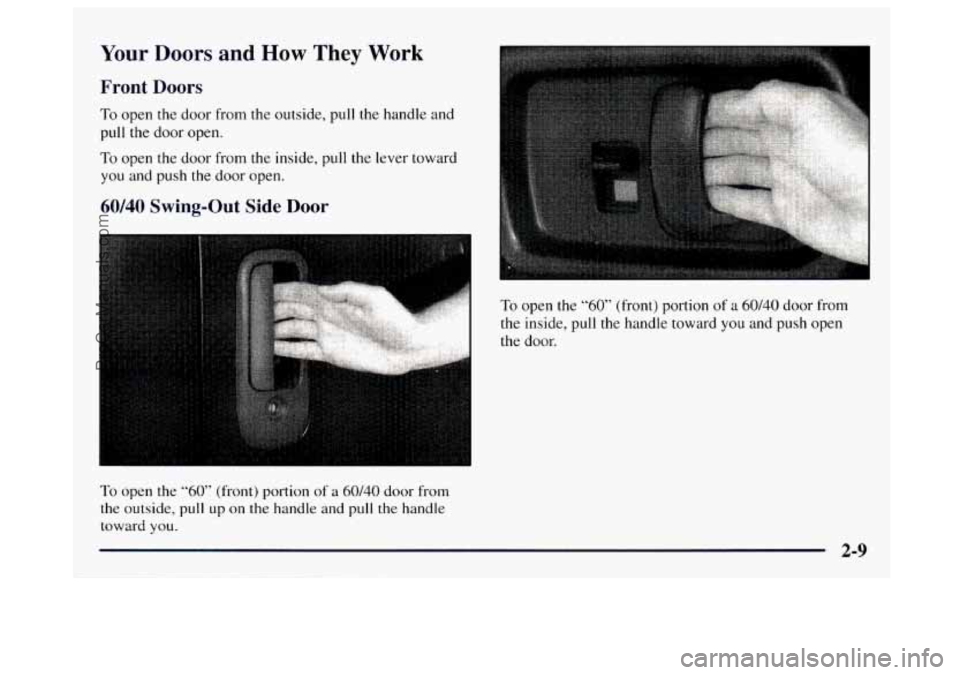
Your Doors and How They Work
Front Doors
To open the door from the outside, pull the handle and
pull the door open.
To open the door from the inside, pull the lever toward
you and push the door open.
60140 Swing-Out Side Door
To open the “60” (front) portion of a 60/40 door from
the inside, pull the handle toward
you and push open
the door.
To open the ”60” (front) portion of a 60/40 door from
the outside, pull up
on the handle and pull the handle
toward
you.
2-9
ProCarManuals.com
Page 72 of 388
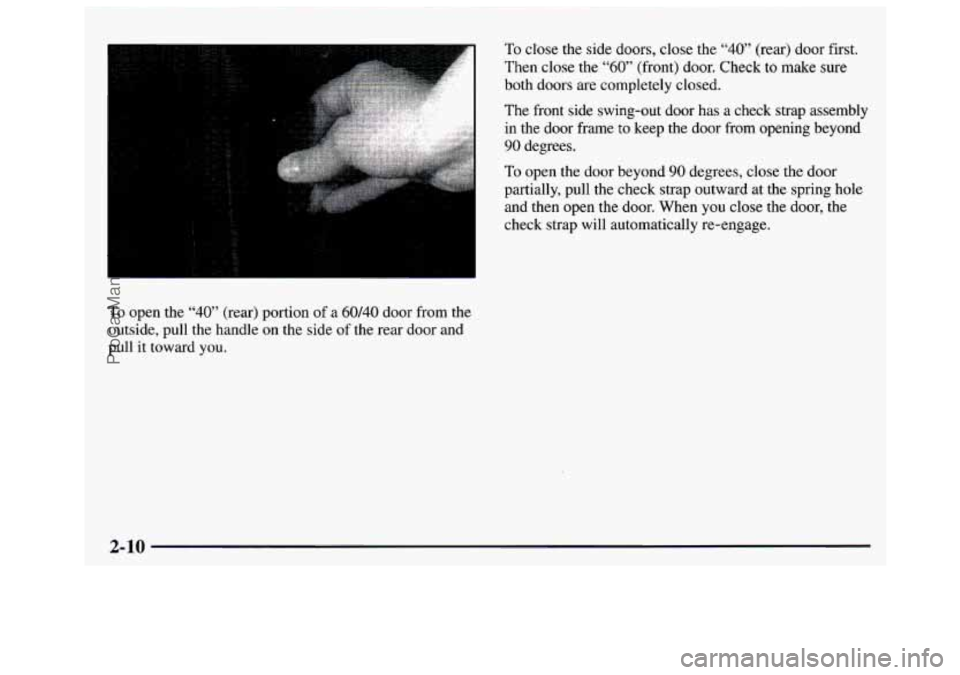
To open the “40” (rear) portion of a 60/40 door from the
outside, pull the handle on the side of the rear door and
pull it toward you.
To close the side doors, close the “40” (rear) door first.
Then
close the “60” (front) door. Check to make sure
both doors are completely closed.
The front side swing-out door has a check strap assembly
in the door frame to keep
the door from opening beyond
90 degrees.
To open the door beyond 90 degrees, close the door
partially, pull the check strap outward at the spring hole
and then open the door. When you close the door, the
check strap will automatically re-engage.
2-10
ProCarManuals.com
Page 73 of 388
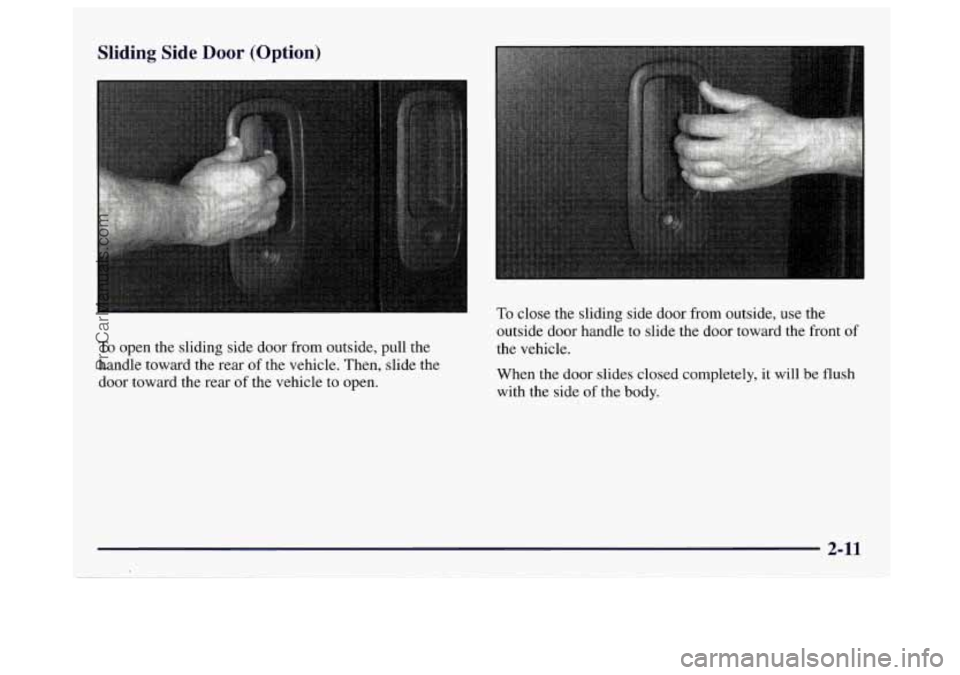
Sliding Side Door (Option)
To open the sliding side door from outside, pull the
handle toward the rear of the vehicle. Then, slide the
door toward the rear of the vehicle to open. To
close the sliding side door from outside, use the
outside door handle to slide the door toward the front of
the vehicle.
When the door slides closed completely, it will be flush
with the side
of the body.
2-11
ProCarManuals.com
Page 74 of 388
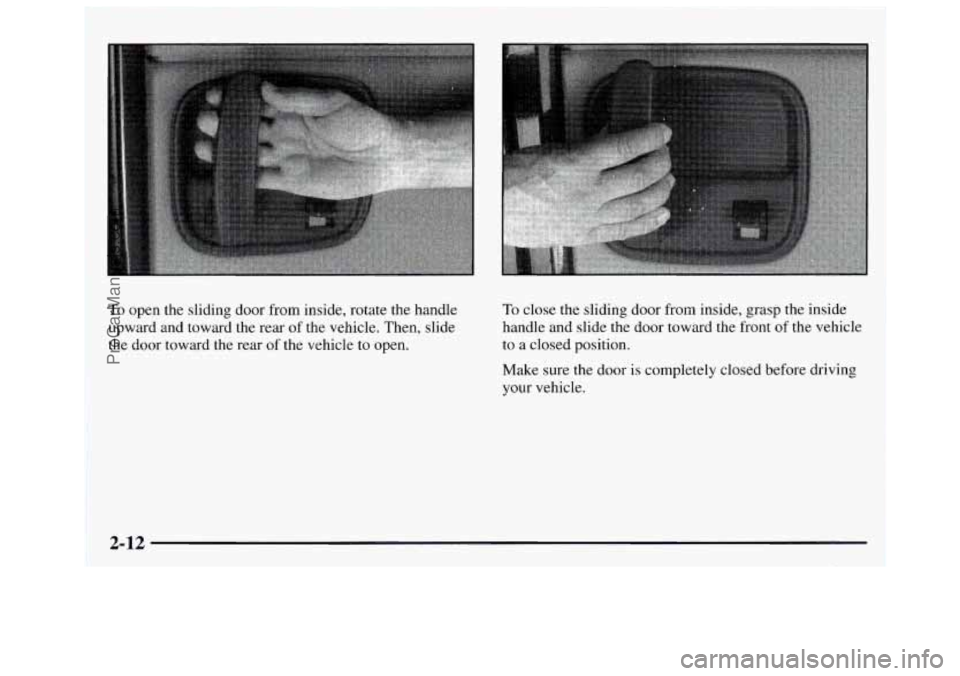
To open the sliding door from inside, rotate the handle
upward and toward the rear
of the vehicle. Then, slide
the door toward the rear
of the vehicle to open.
To close the sliding door from inside, grasp the inside
handle and slide the door toward the front
of the vehicle
to a closed position.
Make sure the door
is completely closed before driving
your vehicle.
2-12
ProCarManuals.com
Page 75 of 388
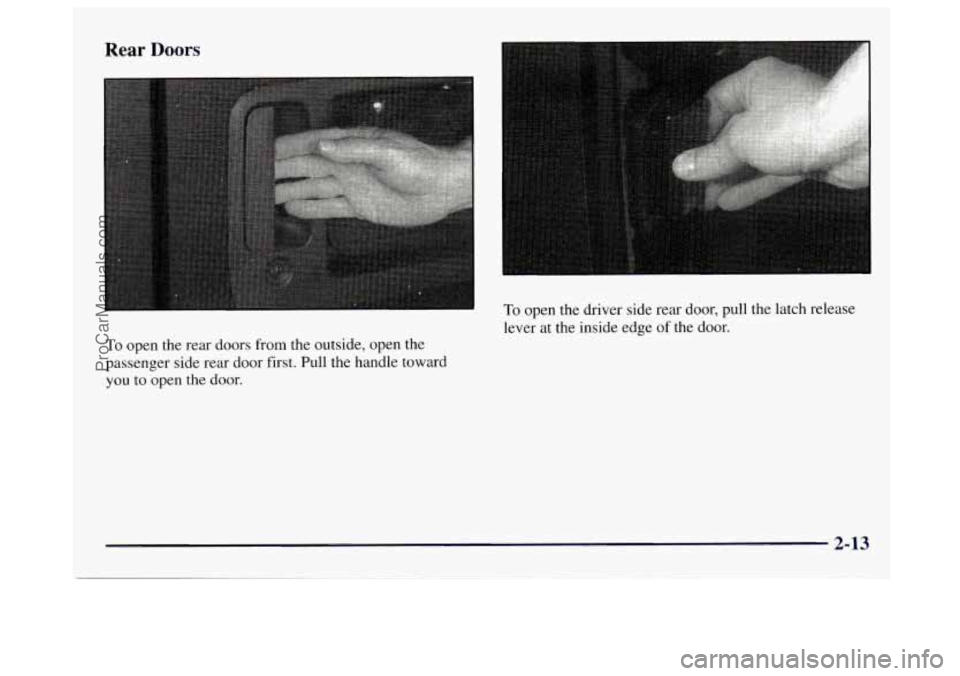
Rear Doors
To open the driver side rear door, pull the latch release
lever at the inside edge of the door.
To open the rear doors from the outside, open the
passenger side rear door first. Pull the handle toward
you
to open the door.
2-13
ProCarManuals.com
Page 76 of 388
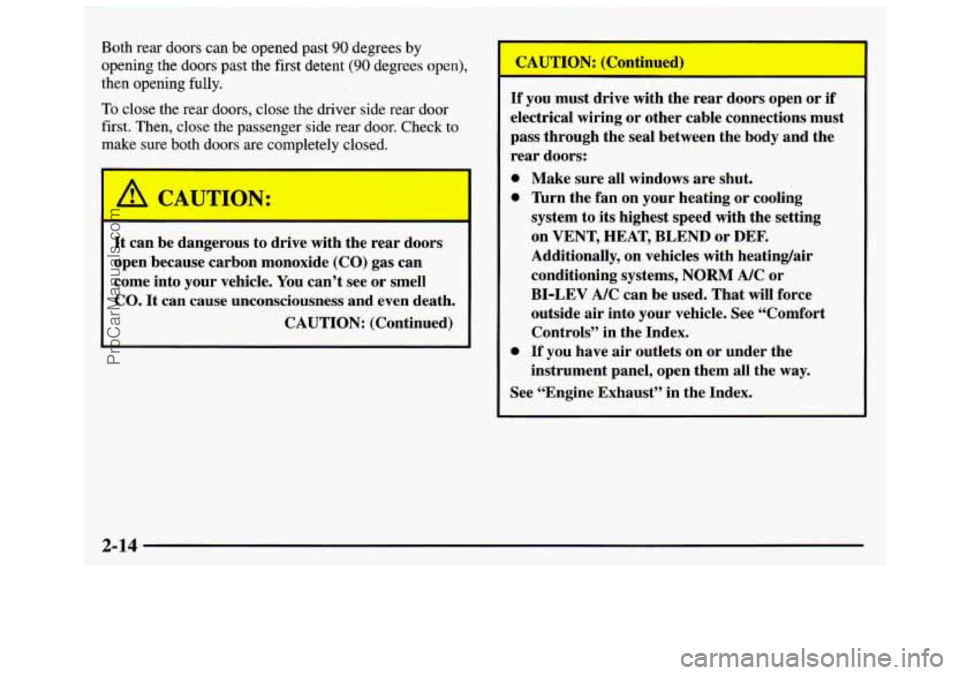
Both rear doors can be opened past 90 degrees by
opening the doors past the first detent
(90 degrees open),
then opening fully.
To close the rear doors, close the driver side rear door
first. Then, close the passenger side rear door. Check to
make sure both doors are completely closed.
It can be dangerous to drive with the rear doors
open because carbon monoxide
(CO) gas can
come into your vehicle. You can’t see or smell
CO. It can cause unconsciousness and even death.
CAUTION: (Continued)
If you must drive with the rear doors open or if
electrical wiring or other cable connections must
pass through the seal between the body and the
rear doors:
0
0
0
Make sure all windows are shut.
Turn the fan on your heating or cooling
system to its highest speed with the setting
on VENT, HEAT, BLEND or DEF.
Additionally, on vehicles with heatingair
conditioning systems,
NORM A/C or
BI-LEV
A/C can be used. That will force
outside
air into your vehicle. See “Comfort
Controls” in the Index.
If you have air outlets on or under the
instrument panel, open them all the way.
See “Engine Exhaust” in the Index.
2-14
ProCarManuals.com
Page 77 of 388
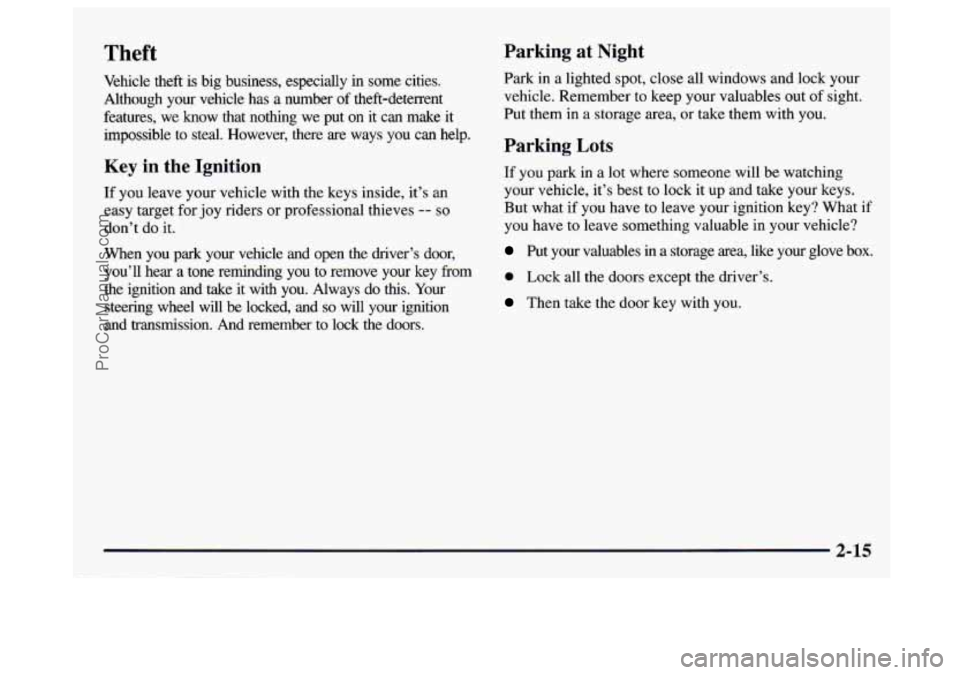
Theft Parking at Night
Vehicle theft is big business, especially in some cities.
Although your vehicle has
a number of theft-deterrent
features, we know that nothing we put on it
can make it
impossible to steal. However, there are ways
you can help.
Key in the Ignition
If you leave your vehicle with the keys inside, it’s an
easy target for joy riders or professional thieves -- so
don’t do it.
When you park your vehicle and open the driver’s door,
you’ll hear a tone reminding you to remove your key from
the ignition and take
it with you. Always do this. Your
steering wheel will be locked, and so will your ignition
and transmission. And remember to lock the doors. Park in
a lighted spot, close
all windows and lock your
vehicle. Remember
to keep your valuables out of sight.
Put them
in a storage area, or take them with you.
Parking Lots
If you park in a lot where someone will be watching
your vehicle, it’s best
to lock it up and take your keys.
But what if you have to leave your ignition key? What if
you have
to leave something valuable in your vehicle?
Put your valuables in a storage area, like your glove box.
0 Lock all the doors except the driver’s.
Then take the door key with you.
ProCarManuals.com
Page 78 of 388
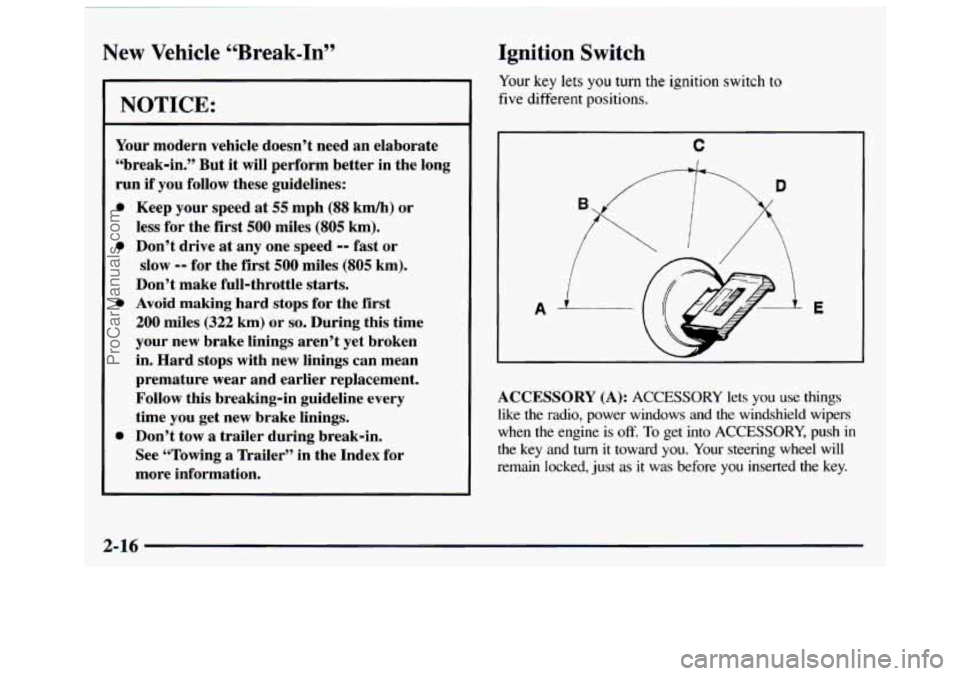
New Vehicle “Break-In”
NOTICE:
Your modern vehicle doesn’t need an elaborate
“break-in.”
But it will perform better in the long
run if you follow these guidelines:
0
0
0
0
Keep your speed at 55 mph (88 km/h) or
less for the
first 500 miles (805 km).
Don’t drive at any one speed
-- fast or
slow
-- for the first 500 miles (805 km).
Don’t make full-throttle starts.
Avoid making hard
stops for the first
200 miles (322 km) or so. During this time
your new brake linings aren’t yet broken
in. Hard stops with new linings can mean
premature wear and earlier replacement.
Follow this breaking-in guideline every
time you get new brake linings.
Don’t tow
a trailer during break-in.
See “Towing a Trailer’’ in the Index for
more information.
Ignition Switch
Your key lets you turn the ignition switch to
five different positions.
A E
ACCESSORY (A): ACCESSORY lets you use things
like the radio, power windows and the windshield wipers
when the engine is
off. To get into ACCESSORY, push in
the key and turn it toward
you. Your steering wheel will
remain locked, just
as it was before you inserted the key.
2-16
ProCarManuals.com
Page 79 of 388
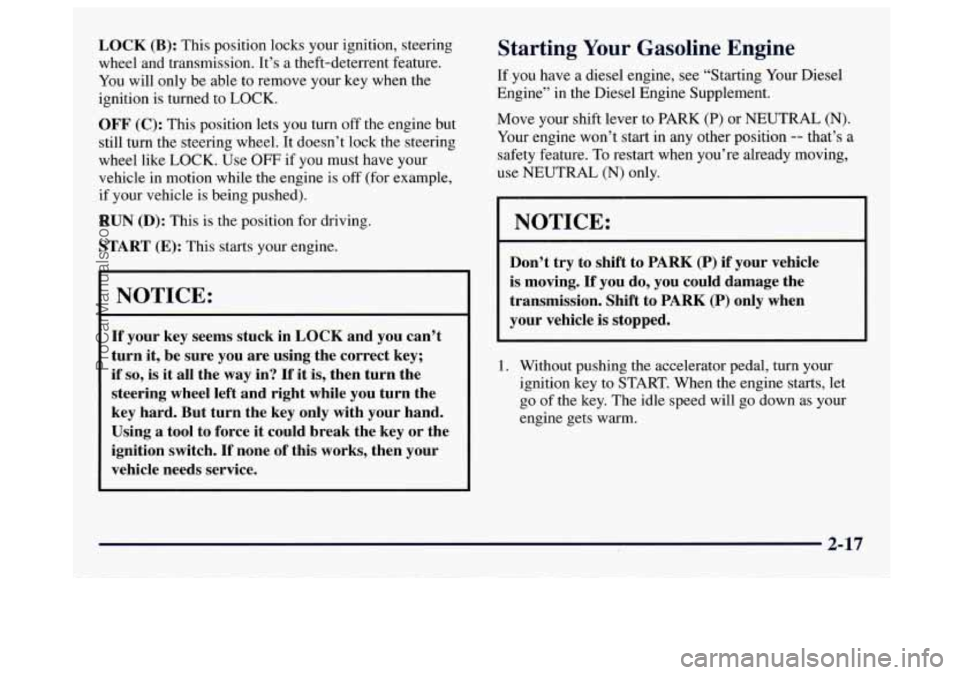
LOCK (B): This position locks your ignition, steering
wheel and transmission. It’s a theft-deterrent feature.
You will only be able to remove your key when the
ignition is turned to
LOCK.
OFF (C): This position lets you turn off the engine but
still turn the steering wheel. It doesn’t lock the steering
wheel like
LOCK. Use OFF if you must have your
vehicle in motion while the engine is off (for example,
if your vehicle is being pushed).
RUN (D): This is the position for driving.
START (E): This starts your engine.
I NOTICE:
If your key seems stuck in LOCK and you can’t
turn it, be sure you are using the correct key;
if
so, is it all the way in? If it is, then turn the
steering wheel left and right while you turn the
key hard. But turn the key only with your hand.
Using a tool to force it could break the key or the
ignition switch.
If none of this works, then your
vehicle needs service.
Starting Your Gasoline Engine
If you have a diesel engine, see “Starting Your Diesel
Engine” in the Diesel Engine Supplement.
Move your shift lever to PARK (P)
or NEUTRAL (N).
Your engine won’t start in any other position -- that’s a
safety feature.
To restart when you’re already moving,
use NEUTRAL
(N) only.
NOTICE:
Don’t try to shift to PARK (P) if your vehicle
is moving.
If you do, you could damage the
transmission. Shift to PARK (P) only when
your vehicle is stopped.
1. Without pushing the accelerator pedal, turn your
ignition key to START. When the engine starts, let
go of the key. The idle speed will go down as your
engine gets warm.
2-17
ProCarManuals.com
Page 80 of 388
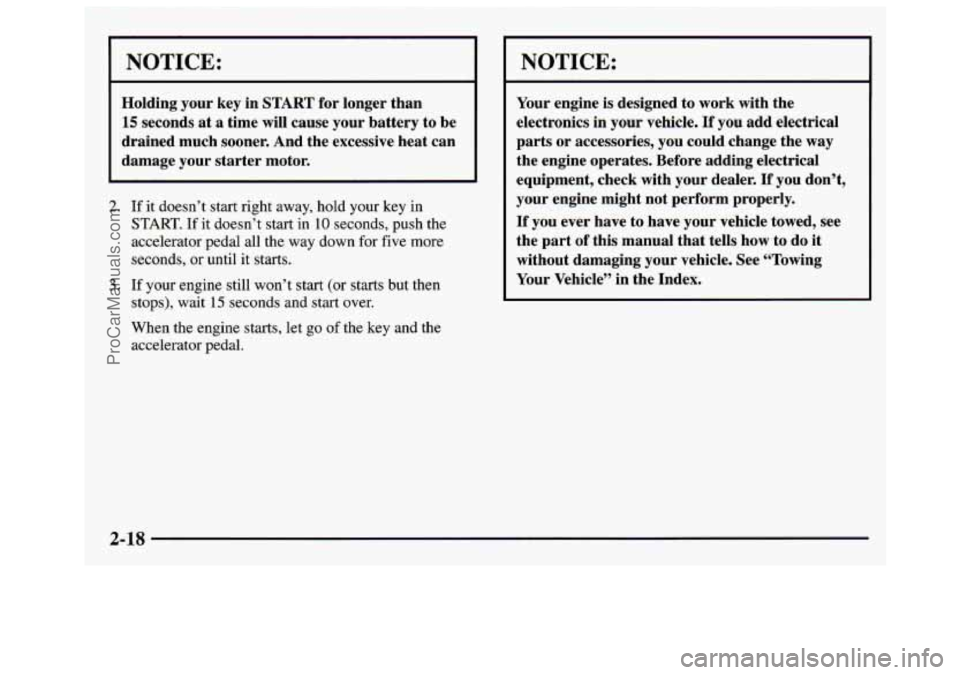
I NOTICE:
Holding your key in START for longer than
15 seconds at a time will cause your battery to be
drained much sooner. And the excessive heat can
damage your starter motor.
2. If it doesn’t start right away, hold your key in
START. If it doesn’t start in 10 seconds, push the
accelerator pedal all the way down for five more
seconds, or until it starts.
3. If your engine still won’t start (or starts but then
stops), wait
15 seconds and start over.
When the engine starts, let go of the key and the
accelerator pedal.
I
NOTICE:
Your engine is designed to work with the
electronics in your vehicle.
If you add electrical
parts or accessories, you could change the way
the engine operates. Before adding electrical
equipment, check with your dealer.
If you don’t,
your engine might not perform properly.
If you ever have to have your vehicle towed, see
the part
of this manual that tells how to do it
without damaging your vehicle. See “Towing
Your Vehicle’’ in the Index.
2-18
ProCarManuals.com